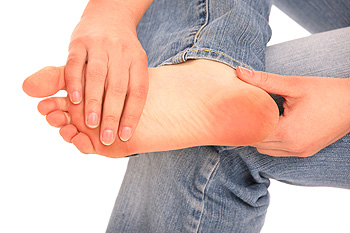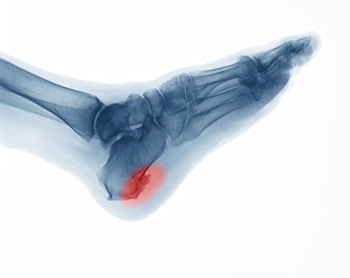Items filtered by date: March 2019
Understanding Your Foot Pain
 Foot pain is a broad term that covers many different types of pain. The foot is a complex part of the body that is comprised of many bones, ligaments and muscles; therefore, pain can be felt in various parts of the feet. The degree of pain or discomfort felt can highly differ. Pain can present itself as throbbing, aching, stabbing, or mild tenderness. Understanding and learning about your foot pain is key in figuring out what the underlying issue is. Some of the most common foot conditions that cause pain are plantar fasciitis, tarsal tunnel syndrome, metatarsalgia, Morton's neuroma, and Achilles tendinitis. All of these conditions cause pain in different locations and result in different types of pain. If you are experiencing any foot pain, speak with a podiatrist who can properly diagnose and treat the ailment.
Foot pain is a broad term that covers many different types of pain. The foot is a complex part of the body that is comprised of many bones, ligaments and muscles; therefore, pain can be felt in various parts of the feet. The degree of pain or discomfort felt can highly differ. Pain can present itself as throbbing, aching, stabbing, or mild tenderness. Understanding and learning about your foot pain is key in figuring out what the underlying issue is. Some of the most common foot conditions that cause pain are plantar fasciitis, tarsal tunnel syndrome, metatarsalgia, Morton's neuroma, and Achilles tendinitis. All of these conditions cause pain in different locations and result in different types of pain. If you are experiencing any foot pain, speak with a podiatrist who can properly diagnose and treat the ailment.
Foot Pain
Foot pain can be extremely painful and debilitating. If you have a foot pain, consult with Leonora Fihman, DPM from California. Our doctor will assess your condition and provide you with quality foot and ankle treatment.
Causes
Foot pain is a very broad condition that could be caused by one or more ailments. The most common include:
- Bunions
- Hammertoes
- Plantar Fasciitis
- Bone Spurs
- Corns
- Tarsal Tunnel Syndrome
- Ingrown Toenails
- Arthritis (such as Gout, Rheumatoid, and Osteoarthritis)
- Flat Feet
- Injury (from stress fractures, broken toe, foot, ankle, Achilles tendon ruptures, and sprains)
- And more
Diagnosis
To figure out the cause of foot pain, podiatrists utilize several different methods. This can range from simple visual inspections and sensation tests to X-rays and MRI scans. Prior medical history, family medical history, and any recent physical traumatic events will all be taken into consideration for a proper diagnosis.
Treatment
Treatment depends upon the cause of the foot pain. Whether it is resting, staying off the foot, or having surgery; podiatrists have a number of treatment options available for foot pain.
If you have any questions, please feel free to contact our offices located in Encino and Brentwood, Los Angeles, CA . We offer the newest diagnostic and treatment technologies for all your foot care needs.
Risk Factors for Athlete’s Foot
Contracting athlete’s foot can happen to anyone, but there are some risk factors that increase the chance of contracting this inconvenient condition. Public places like locker rooms, showers, and swimming pools are breeding grounds for bacteria, so exposing your bare feet to surfaces in these environments could easily lead to athlete’s foot. Sharing footwear or towels with someone who has been infected can spread the infection, so it’s best to avoid sharing these items. Wet or sweaty feet are also at a higher risk than feet that are kept dry and clean, because bacteria thrive in moist environments. Minor skin or nail injuries, especially in tight closed-toe shoes are also a risk factor. If you think you might have athlete’s foot or would like additional information on how to prevent it, then it is suggested you speak with a podiatrist.
Athlete’s foot is an inconvenient condition that can be easily reduced with the proper treatment. If you have any concerns about your feet and ankles, contact Leonora Fihman, DPM from California. Our doctor will treat your foot and ankle needs.
Athlete’s Foot: The Sole Story
Athlete's foot, also known as tinea pedis, can be an extremely contagious foot infection. It is commonly contracted in public changing areas and bathrooms, dormitory style living quarters, around locker rooms and public swimming pools, or anywhere your feet often come into contact with other people.
Solutions to Combat Athlete’s Foot
- Hydrate your feet by using lotion
- Exfoliate
- Buff off nails
- Use of anti-fungal products
- Examine your feet and visit your doctor if any suspicious blisters or cuts develop
Athlete’s foot can cause many irritating symptoms such as dry and flaking skin, itching, and redness. Some more severe symptoms can include bleeding and cracked skin, intense itching and burning, and even pain when walking. In the worst cases, Athlete’s foot can cause blistering as well. Speak to your podiatrist for a better understanding of the different causes of Athlete’s foot, as well as help in determining which treatment options are best for you.
If you have any questions please feel free to contact our offices located in Encino and Brentwood, Los Angeles, CA . We offer the newest diagnostic and treatment technologies for all your foot and ankle needs.
Can Ingrown Toenails Be Prevented?
 Patients who have ingrown toenails are often aware of the pain they may cause. It occurs when the side of the nail grows into the skin surrounding the big toe, and may often look red and swollen. Additionally, some people may notice a discharge coming from the affected area, and may have chills or feel warm. There are measures that can be implemented, which may prevent ingrown toenails from developing. These may include trimming the toenails to the correct length and width, and wearing shoes that fit correctly with adequate room for the toes to move freely in. Mild relief may be found if the toe is soaked in warm water several times per day, in addition to wearing open-toe sandals. If you are a diabetic patient, or if your ingrown toenail causes extreme pain, it is suggested to seek the counsel of a podiatrist who can properly treat this condition.
Patients who have ingrown toenails are often aware of the pain they may cause. It occurs when the side of the nail grows into the skin surrounding the big toe, and may often look red and swollen. Additionally, some people may notice a discharge coming from the affected area, and may have chills or feel warm. There are measures that can be implemented, which may prevent ingrown toenails from developing. These may include trimming the toenails to the correct length and width, and wearing shoes that fit correctly with adequate room for the toes to move freely in. Mild relief may be found if the toe is soaked in warm water several times per day, in addition to wearing open-toe sandals. If you are a diabetic patient, or if your ingrown toenail causes extreme pain, it is suggested to seek the counsel of a podiatrist who can properly treat this condition.
Ingrown toenails can become painful if they are not treated properly. For more information about ingrown toenails, contact Leonora Fihman, DPM of California. Our doctor can provide the care you need to keep you pain-free and on your feet.
Ingrown Toenails
Ingrown toenails occur when a toenail grows sideways into the bed of the nail, causing pain, swelling, and possibly infection.
Causes
- Bacterial infections
- Improper nail cutting such as cutting it too short or not straight across
- Trauma to the toe, such as stubbing, which causes the nail to grow back irregularly
- Ill-fitting shoes that bunch the toes too close together
- Genetic predisposition
Prevention
Because ingrown toenails are not something found outside of shoe-wearing cultures, going barefoot as often as possible will decrease the likeliness of developing ingrown toenails. Wearing proper fitting shoes and using proper cutting techniques will also help decrease your risk of developing ingrown toenails.
Treatment
Ingrown toenails are a very treatable foot condition. In minor cases, soaking the affected area in salt or antibacterial soaps will not only help with the ingrown nail itself, but also help prevent any infections from occurring. In more severe cases, surgery is an option. In either case, speaking to your podiatrist about this condition will help you get a better understanding of specific treatment options that are right for you.
If you have any questions please feel free to contact our offices located in Encino and Brentwood, Los Angeles, CA . We offer the newest diagnostic and treatment technologies for all your foot and ankle needs.
What Are Heel Spurs?
 There are many conditions that can cause discomfort in the heel, but one of the most common is heel spurs. A small calcium deposit forms and can eventually extend from your heel bone to your arch. Symptoms associated with heel spurs are pain, inflammation, and swelling at the front of your heel. The heel might also feel warm, and over time, a small protrusion could be visible. Some heel spurs can go unnoticed and only become apparent on an X-ray. Heel spurs develop over time, so they will not suddenly appear. Distinguishing heel spurs from other conditions that cause heel pain can be hard to do on your own, so if you are experiencing heel pain then it is suggested that you speak with a podiatrist who can properly diagnosis you.
There are many conditions that can cause discomfort in the heel, but one of the most common is heel spurs. A small calcium deposit forms and can eventually extend from your heel bone to your arch. Symptoms associated with heel spurs are pain, inflammation, and swelling at the front of your heel. The heel might also feel warm, and over time, a small protrusion could be visible. Some heel spurs can go unnoticed and only become apparent on an X-ray. Heel spurs develop over time, so they will not suddenly appear. Distinguishing heel spurs from other conditions that cause heel pain can be hard to do on your own, so if you are experiencing heel pain then it is suggested that you speak with a podiatrist who can properly diagnosis you.
Heel spurs can be incredibly painful and sometimes may make you unable to participate in physical activities. To get medical care for your heel spurs, contact Leonora Fihman, DPM from California. Our doctor will do everything possible to treat your condition.
Heels Spurs
Heel spurs are formed by calcium deposits on the back of the foot where the heel is. This can also be caused by small fragments of bone breaking off one section of the foot, attaching onto the back of the foot. Heel spurs can also be bone growth on the back of the foot and may grow in the direction of the arch of the foot.
Older individuals usually suffer from heel spurs and pain sometimes intensifies with age. One of the main condition's spurs are related to is plantar fasciitis.
Pain
The pain associated with spurs is often because of weight placed on the feet. When someone is walking, their entire weight is concentrated on the feet. Bone spurs then have the tendency to affect other bones and tissues around the foot. As the pain continues, the feet will become tender and sensitive over time.
Treatments
There are many ways to treat heel spurs. If one is suffering from heel spurs in conjunction with pain, there are several methods for healing. Medication, surgery, and herbal care are some options.
If you have any questions feel free to contact our offices located in Encino and Brentwood, Los Angeles, CA . We offer the latest in diagnostic and treatment technology to meet your needs.



